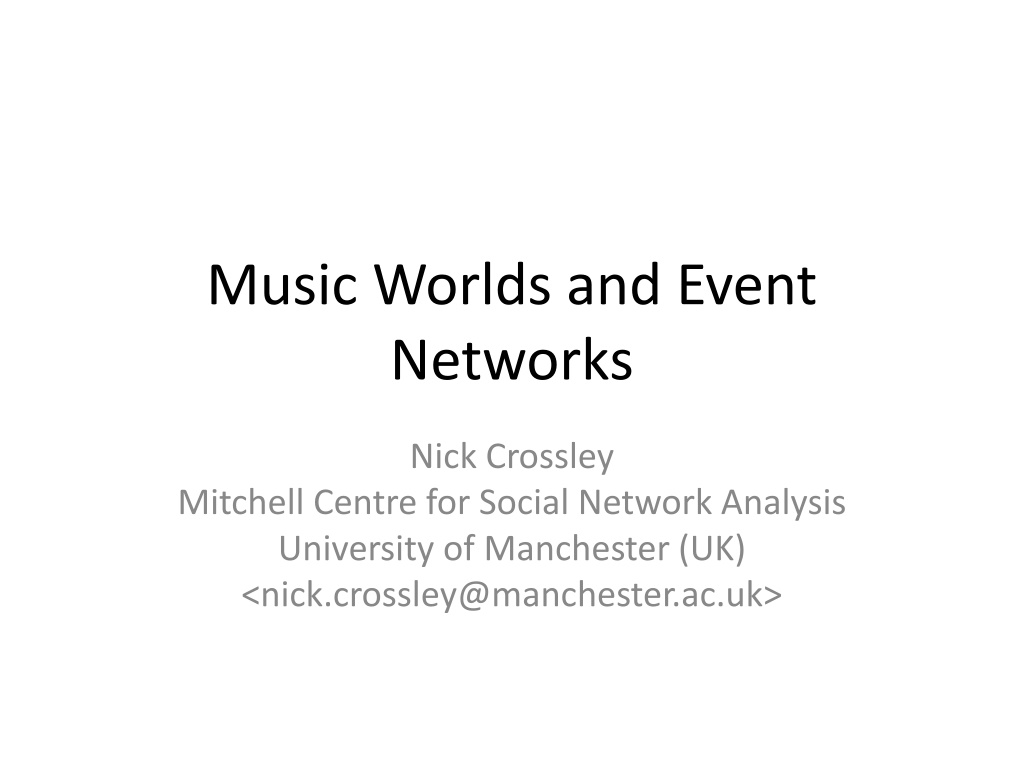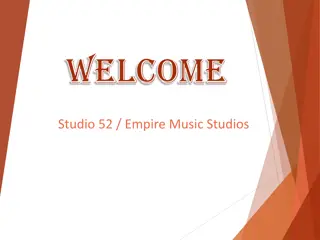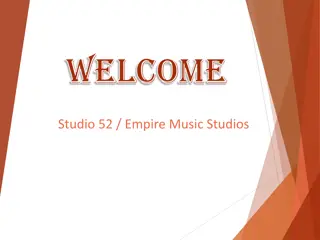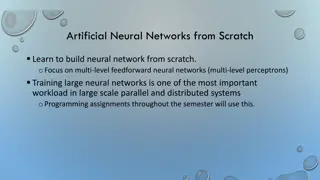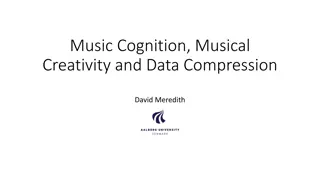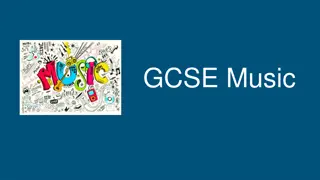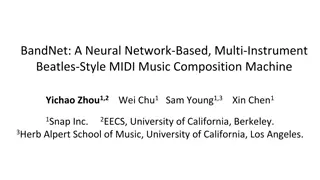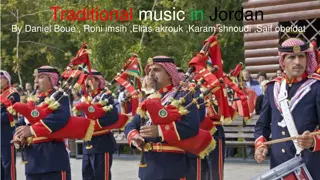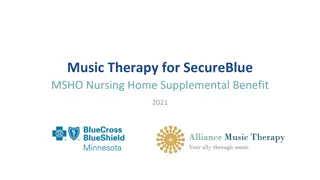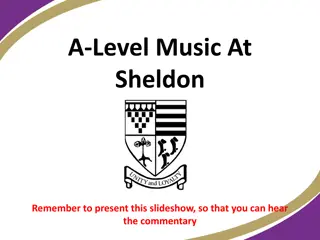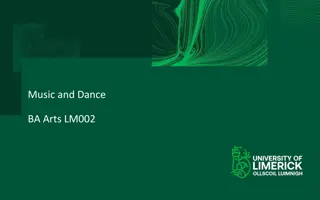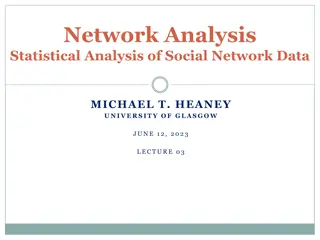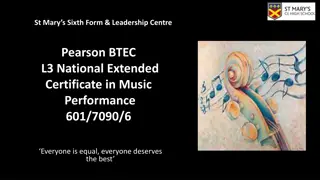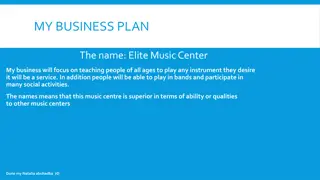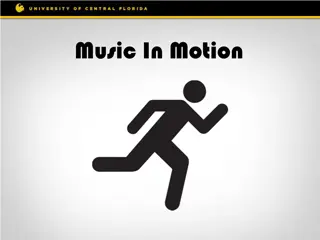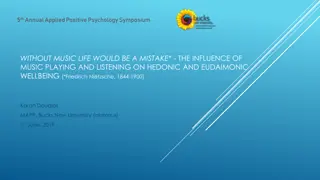Music Worlds and Event Networks
Music worlds and event networks are clusters of musical interaction centered around various factors like location, style, and organization. This study delves into the episodic nature of music worlds, focusing on gigs and festivals as key events that bring these worlds to life periodically. The flow of subsets of participants within these events shapes local cultures, identities, and social structures. Through the analysis of participant networks and event networks, we uncover the spatio-temporal dynamics and structural properties of these interconnected music worlds.
Download Presentation

Please find below an Image/Link to download the presentation.
The content on the website is provided AS IS for your information and personal use only. It may not be sold, licensed, or shared on other websites without obtaining consent from the author.If you encounter any issues during the download, it is possible that the publisher has removed the file from their server.
You are allowed to download the files provided on this website for personal or commercial use, subject to the condition that they are used lawfully. All files are the property of their respective owners.
The content on the website is provided AS IS for your information and personal use only. It may not be sold, licensed, or shared on other websites without obtaining consent from the author.
E N D
Presentation Transcript
Music Worlds and Event Networks Nick Crossley Mitchell Centre for Social Network Analysis University of Manchester (UK) <nick.crossley@manchester.ac.uk>
Music worlds are clusters of musical interaction, centred around a location, musical style, form of organisation and/or a political orientation. Can have trans-local and/or virtual dimensions. Might be entirely translocal/virtual. Previously analysed as networks of participants.
Participant networks are important but only offer a partial perspective on music worlds. They fail to capture the episodic nature of music worlds and the spatio-temporal dispersal of their constitutive events. Worlds are latent much of the time, only coming to life periodically via collective events (e.g. gigs, festivals, rehearsals). Participants don t play their musical roles all of the time. They switch into them for such events. Henceforth the events we are interested in are gigs and festivals.
Gigs are bounded in time and space. They have beginnings, endings and barriers excluding outsiders. But within worlds they are linked by a flow of subsets of the same participants (artists, audiences and support personnel . This facilitates: A flow of resources. The formation/reproduction of (i) a local culture, (ii) a collective identity, (iii) interpersonal connections and local social structure (i.e. participant networks ). Gigs are shaped by what/who flows into them, and shape subsequent gigs by what/who flows out of them. The event network makes a difference to the events.
Two-mode studies sometimes capture events. But often only as a means of deriving participant networks. And they typically ignore both sequential structure and spatio-temporal dispersion. Time adds structure to a network: e.g. Ties are asymmetrically directed. Earlier events have a decreased likelihood of amassing in-degree. Later events have a decreased likelihood of amassing out-degree.
A two-mode network of underground heavy metal gigs: 474 audience members, 201 artists/bands 148 underground metal events. Spread across 3 months and 6 English cities.
A single-mode projection brings certain structural properties to light: e.g. two isolates + one component; possible core- periphery. But time and space are absent. And not only from the graph from our concept of the network
We need also to think about the network like this: TIME Bristol London Birmingham Liverpool Manchester Leeds
What about of Lerner and Lomis (2022) relational hyperevent models? This is a definite possibility for the future. Lerner and Lomi s intuitions are quite similar to my own. And it is difficult to factor time in by other means. But, As with all models (i) a huge amount of potentially relevant and interesting detail is bracketed out, (ii) there is a danger that we investigate what the model allows us to investigate rather than what might be (more) substantively relevant and important. RHEMs are still at an early stage of development and therefore quite limited. For the present I prefer more basic and descriptive methods.
Some Preliminary Analyses of the underground metal networks
Distribution of Events Across Time (Days by Cumulative Frequency) Events are evenly distributed but with episodic steps (weekends). Reflecting audience availability?
Do particular combinations of participants recur? Participant Type Bands Promoters Venues Number of Gigs Min 2 2 2 Max 15 88 72 Mean 3.9 16.4 14.6 Bands Worked With (2-3 per gig) Min 1 1 6 Max 55 97 106 Mean 10.1 26.6 28.3 Promoters Worked With (generally one per gig) Min 0 0 1 Max 10 5 9 Mean 2.3 1.6 3 Venues Used (one per gig) Min 1 1 n/a Max 10 11 n/a Mean 2.5 3 n/a
Distribution of Events By Place Why do London and Manchester dominate? Unequal opportunity to participate.
Local and Translocal Participant Flows Density Matrix and E-I Birmingham Bristol Leeds Liverpool London Manchester Birmingham .38 .03 .05 .05 .09 .09 Bristol .16 .05 .04 .04 .04 Leeds .49 .08 .05 .14 Liverpool .16 .07 .15 London .42 .14 Manchester .43 Expected E-I = .576 Observed E-I = -.107** There is geographical homophily in the network, pointing to the existence of local worlds. But local worlds are linked, so we have translocality too. Actually, audience flows tend to be geographically homophilous, whilst artist flows are heterophilous. Expected E-I = .58, Audience Observed -.21**, Artist Observed +.88**
However, audiences do travel. And when they do they often follow particular bands. We can show this with a QAP logistic regression model. (dependent variable = audience flow) Model 1 Model 2 Model 3 Intercept .08 .155 .067 Geographical Homophily (Odds Ratio) Artist Flow (Odds Ratio) R2 8.73** 9.703** 4.04** 8.267** .15** .01** .165**
Artist and audience flows differ more generally, making a different contribution to the event network. Audience Flow 1 Artist Flow Combined Flow 1 Components (excluding isolates) Size of Main Component (nodes) Isolates 24 146 42 146 2 26 2 Fragmentation 0.03 0.91 0.03 Density 0.14 0.02 0.15 Compactness 0.5 0.05 0.53
Different types of event make a difference too. Mean Scores for Festivals and Standard Gigs (with t tests) All Festivals Standard Gigs Difference Attendees+ Degree Indegree# Outdegree# Translocal Degree Localities 7.2 21 9.95 42.6 64 40 5.99 19 8.7 36.6** 45** 31.3** 9.95 8.14 17.6 31 9.6 7.36 8 23.64** 3.3 5.2 3.3 1.9* + These are numbers of survey respondents in attendance, not all attendees. # Based upon a reduced network for which dates were available. *p<.05 **p<.000 Translocal degree = ties to non-local events. Localities = number of other localities tied to But festivals occur late in the sequence
Too much to say, too little time. But thanks for bearing with me!
